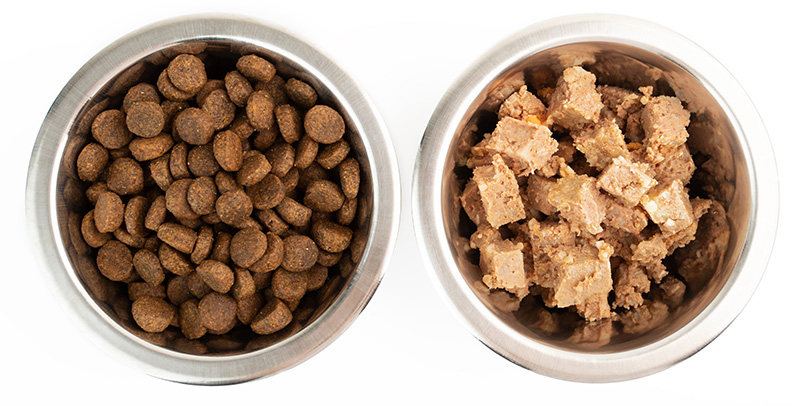This article was published in the November 2024 issue of Pet Food Processing. Read it and other articles from this issue in our November digital edition.
A pet food product can offer a well-formulated blend of nutrition and sustainably sourced fresh ingredients for a reasonable price, but all those selling points simply won’t matter if the food doesn’t appeal to the dogs or cats it is intended to nourish.
Ensuring products are palatable involves a wide range of considerations, from moisture levels to nutrition content, and appropriate testing is key to ensure more products are widely acceptable to pets.
Factoring taste into formulation
In addition to factors like nutrition, food science, manufacturing, sustainability and pricing, palatability is one of the top considerations that must be kept in mind when developing pet food products, said Emilie Mesnier, vice president of European operations at BSM Partners, Nantes, France.
Overall, moisture content is a critical component of palatability for both cats and dogs as they both prefer moist options reminiscent of fresh meat, said Leah Lambrakis, vice president of research and development for nutrition and scientific affairs at Simmons Pet Food, Siloam Springs, Ark. Even so, kibble is also widely accepted.
“When formulating pet foods for optimal nutrition, it’s essential to consider the sources and inclusion levels of ingredients as these factors also significantly impact palatability,” said Leah Lambrakis of Simmons Pet Food.
“When formulating pet foods for optimal nutrition, it’s essential to consider the sources and inclusion levels of ingredients as these factors also significantly impact palatability,” Lambrakis said. “High-quality ingredients enhance a pet’s enjoyment of their food, while the right balance ensures optimal flavor and texture.”
For dogs, the primary driver of palatability is smell with up to a 90% correlation between smell and taste preference, Mesnier said. The other top considerations for dogs include moisture and texture. Overall, dogs have around 200 million olfactive neurons that represent approximately 10% of their brain dedicated to olfaction, said Sara Martins, global director of research and development at St. Charles, Mo.-based AFB International.
While smell is essential in ensuring dogs will accept a food, Mesnier said moisture is also important as even a small increase in moisture can increase acceptability.
Dogs also generally favor the taste of higher-calorie formats, but this results in the need to balance the pet’s total caloric intake when prioritizing palatability in formulations, Lambrakis said.
Other factors need to be balanced as well.
“Palatants must overcome any off flavors from added nutritional components like vitamins, minerals and functional ingredients while maintaining overall product appeal,” said Emilie Mesnier of BSM Partners.
“Palatants must overcome any off flavors from added nutritional components like vitamins, minerals and functional ingredients while maintaining overall product appeal,” Mesnier said. “Balancing palatability, nutritional value, marketing needs and cost is essential to creating a successful product that dogs will consistently enjoy and that meets the demands of both pet parents and the market.”
Cats, being more finicky than canines, prioritize texture, nutrition, moisture, mouthfeel and digestibility, Mesnier said. Cats often prefer — and sometimes reject — certain ingredients, with peas being one that usually leads to decreased acceptance, as well as oxidized fats and meat meals. At the same time, watching fiber content is also critical as including the wrong soluble to insoluble fiber ratio can negatively impact digestion, and Mesnier said cats are very sensitive to how food makes them feel while they digest it.
Felines are also very sensitive to texture and mouthfeel, so balancing food science, palatability knowledge, moisture and processing factors are critical part of formulation. Mesnier said while texture and moisture have been studied extensively with kibble products, the industry could benefit from additional research on new formats like air-dried, freeze-dried and fresh/frozen foods.
Cats prefer diets higher in protein and lower in carbohydrates when given a choice, and they have significantly fewer taste receptors compared to dogs and humans that limits their ability to perceive sweet, sour, salty and bitter flavors, Lambrakis said.
Mesnier also recommends making sure a product’s claims and messaging don’t interfere with nutrition and palatability as she has seen some emerging brands struggle to gain a consumer base due to low consumption in novel formats because the products did not use a palatant.
“Often with younger brands and startups, palatability considerations can be at odds with over-emphasis on price targets, marketing claims and branding philosophies,” Mesnier said.
Abby Castillo, senior global product manager for palatants and health and nutrition for Des Moines, Iowa-based Kemin, echoed this idea saying the need for a pet to be drawn to a food should always be prioritized over top trends. She said recent supply chain difficulties led the industry to try more diverse ingredients, and Kemin has responded to this trend with its P Series line of plant-based palatants that are not at risk for animal disease outbreaks, have fewer export restrictions, and can comply with conventional, vegetarian or limited-ingredient pet food labels.
Testing for acceptability
After all the work has been done to formulate a palatable new product, it must be tested to see how it will be received.

Palatants are added to pet food to mask potential off flavors from added nutritional components.
| Source: ©NEW AFRICA - STOCK.ADOBE.COMTesting is often conducted at third-party facilities with animals trained to respond to different formulations while having consistent eating habits during the trials. Lambrakis said various factors can impact results including the environment and number of animals, as well as the health conditions, age and breed of the animals.
Various testing methods include a two-bowl test that compares two different foods side-by-side to determine if there is a preference, with the bowls switched on the second day to see if there is any bias toward the bowl location. Lambrakis said this testing could be used to evaluate if a difference exists between two diets when one ingredient or flavor enhancer is replaced with another.
Monadic testing is designed to more closely resemble home feeding and determine if the animals eat enough of each offering, fed on two different days, with enough enjoyment to meet their caloric needs.
Cécile Saint-Paul, development and technical services director for Symrise Pet Food North America, St. Louis, Mo., said sometimes companies don’t invest in testing with a large enough sample of animals to properly determine widespread acceptability. Additionally, she said sometimes companies don’t consider the impact a coating can make on the acceptability of their product.
Inside the innovation
Saint-Paul said almost all dry pet food brands use palatants, and another one of their benefits is helping keep the taste of the product steady through any fluctuations of raw materials in the supply chain.
The type of palatant that should be used in a product also depends on the brand’s goals with the product, Saint-Paul explained. The brand might be trying to achieve better palatability than the competitor or simply trying to improve palatability from a product’s previous formulation, and these differing goals could involve using different palatants.
“Paying attention to your application system and your coating system and making sure you have a well-sequenced process between fat, liquid palatants and powder palatants is very key,” Saint-Paul said.
She said she encourages pet food manufacturers to buy the application service in addition to the palatant from their suppliers because adjustments are frequently needed.
Because canines are so driven by smell, liquid palatants usually work best for dog products, Saint-Paul said. For premium products, Saint-Paul said combining a liquid and powder palatant can be very powerful.
Lambrakis said there is no one-size-fits-all approach to palatability, and Simmons has a team dedicated to focusing on technology for palatability.
 Source: ©YTA - STOCK.ADOBE.COM
Source: ©YTA - STOCK.ADOBE.COMBSM is also leveraging data to bolster innovation.
“One key initiative (of BSM) involves building a master database that consolidates all palatability test results across different product forms and species,” Mesnier said. “This allows for trend evaluation and helps BSM deliver actionable insights. Additionally, BSM is creating a comprehensive database of palatants categorized by protein source (chicken, pork, non-meat alternatives), claims and volumes. This enables the team to make fast, accurate recommendations that align with specific client needs, ensuring better product outcomes. We also work closely with our industry partners from AFB, Kemin and Symrise to help match the best palatant for the very specific product needs.”
AFB is also exploring how to use data in innovation.
“At AFB, we aim to take a data-driven approach regarding future innovation utilizing several analytical techniques for chemical characterization of raw materials — focusing on parameters such as protein, ash, fat and moisture, amongst others,” Martins said. “Ensuring robustness and consistency is critical in our innovation strategy. Key steps include comprehensive ingredient analysis and utilizing advanced predictive modeling techniques to classify chemical fingerprints of raw materials and end products for optimal performance.”
The future of palatability
Technology continues to advance palatability as new formats of foods become more popular, Meisner said. New systems are being developed to meet the needs of wet food, kibble, frozen, freeze-dried and air-dried foods, with wet food palatants being designed to maintain flavor through high-temperature sterilization processes and dry food palatants designed to improve adhesion and enhance aroma and texture.
Mesnier said encapsulation also makes sure flavor and nutrition aren’t lost during processing, ensuring optimal taste and health benefits. She said encapsulation also helps support the trend to combine a palatant with other functional ingredients like probiotics.
Saint-Paul said egg protein powder might be used more widely in the future as it is recognized as a sustainable ingredient that offers high-quality protein, is easy to incorporate into products, and achieves positive results when tested. It can also assist manufacturers looking to extrude high-protein, low-starch, grain-free products.
Making foods taste as good or better than they currently do while reducing use of animal proteins will be a challenge going forward, Saint-Paul said.
“We have a roadmap where we have been able to release on the market some non-meat palatants using yeast or pea protein,” Saint-Paul said. “This is where I think the innovation is going — how can you use other protein sources and adapt your processes to still generate some specific palatable molecules that are not coming from chicken or pork liver anymore?”
Castillo said Kemin is exploring a range of palatability factors from sustainable production practices to emulsification to palatant delivery methods, stabilization, customized palatants, unique protein sources, and new molecule development.
“This type of widespread innovation will yield a range of palatants that are no longer ‘one size fits all,’ but will meet the individualized and changing needs of our pet food customers,” Castillo said.
Going forward, a focus on meeting a wider range of palatability needs will be important.
“With a growing focus on individual animal preferences, advanced testing methods like consumption kinetics and automated feeding stations with video recordings and AI (artificial intelligence) analysis are becoming more refined to provide deeper insights into pet food appeal,” Mesnier said. “Innovations will continue to focus on enhancing palatants performance and cost while leveraging available and more sustainable ingredients to cater to society and regulatory demands.”
Read more about product development, ingredients and formulation.



